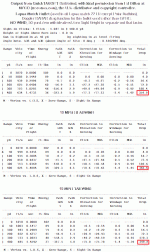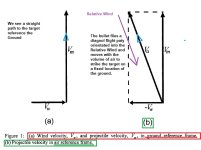I wouldn't think it is applicable to flight of bullet though, i.e. the bullet does feel the wind.
I am editing this for clarity because it seems to be yesterday did not happen.
What I said yesterday is still true today:
What happens is the bullet rotates about its CG until those torque moments equalize the force and the bullet achieves equilibrium just like an airplane.
Yes, it is decelerating from the moment it is fired as a finite amount of thrust force has been applied by the powder charge but does not negate the principle of it achieving equilibrium in the side force yaw axis.
That is an almost instantaneous process as the force is applied. While it is interesting to examine what is going on in that tiny moment in time, it is a Tree and not the Forest. The POSITION of the CG remains the same despite it rotating about its axis.
Those moments about the CG rotate the bullet into what is termed the Relative Wind.
In the Relative Wind, the bullet does not feel the Ground Frame Reference wind and acts exactly like any other aerial vehicle.
The very Definition of Relative Wind is "The Speed and Direction of Air impinging on a body passing thru it. It is equal and opposite in direction to the flight path velocity"
A bullet does not feel the same wind you and I do on the ground, it only feels the Relative Wind and it moves thru a volume of air as a part of that volume of air until it encounters the target or the ground.
A bullet cannot maintain air speed.
No, it has finite amount of thrust imparted upon from the energy of propellent. Like any aerial vehicle is moves towards equilibrium of the forces acting upon. The result of that is a constant deceleration the moment it leaves the muzzle until it encounters the target or the earth. That movement is the result of that quest for force equilibrium and why the bullet does not just drop to the ground the moment it leaves the muzzle.
If the bullet moves with the air mass, the wind deflection would have been
W=Vw*TOF
It most certainly does. Your formulation just does a good job at hiding it from you and your formula is not about the forces acting on the bullet but rather a crude attempt to predict the location of the bullet on the target. It tells you nothing about what is going on during the flight. Does it account for lift? No. Bullets have lift due to the magnus effect and side force due to drag/magnus effects....
In an M24 SWS, One click to the right at a target 500 meters or more tells me where the bullet will be due to spindrift but it tells me nothing about what caused it to be there. That click is your math in action.
Your Tlag is a ratio of a theoretical flight thru a vacuum and the actual flight. So there is some very simplistic aerodynamics that gets covered up in late 17th Century math. Your formula lumps everything into a crude ratio to approximate a prediction not on what the forces are acting on the bullet are doing but where the bullet will be.....
It is not the math for telling you what is going on but rather the math to tell you where it will be....
The first is gravitational force; the other is aerodynamics. Several kinds of aerodynamic forces act on a bullet: drag, lift, side forces, Magnus force, spin damping force, pitch damping force, and Magnus cross force.
https://www.sierrabullets.com/exterior-ballistics/3-0-exterior-ballistic-effects-on-bullet-flight/
Isn't that sort of an odd usage of the word 'path' given that the trajectory is clearly different?
Frame of Reference....
From the Frame of Reference of the ground, the trajectory is different.
From the Frame of Reference of the Air the trajectory is the same and since the volume of air is moving.... the bullet strikes the target at a different point along that same trajectory.


